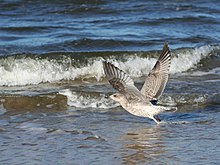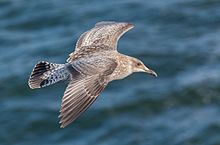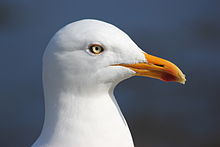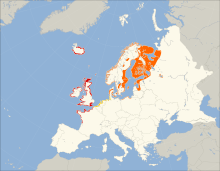European herring gull
The Herring Gull (Larus argentatus) is a bird species within the gulls (Larinae) and the most common large gull in northern and western Europe. Its range extends from the White Sea to the coasts of Fennoscandia, the Baltic Sea, the North Sea and the English Channel, as well as large parts of the Atlantic coast of France and the British Isles. The species is also found in Iceland.
Herring Gulls are colony breeders whose breeding sites are usually on inaccessible islands or cliffs. In many places, however, the species also breeds in dune areas or salt marshes. Like most gulls, it is omnivorous, but feeds mainly on crustaceans and molluscs, fish and human waste. While northern populations are migratory, most remaining herring gulls remain near their breeding grounds. However, young herring gulls in particular sometimes migrate long distances and can then be found far inland. After the species was severely decimated in the 19th century by egg collection and hunting, populations recovered during the 20th century.
The herring gull has often been the subject of research and is very well studied as a species. In particular, the behavioural scientist Nikolaas Tinbergen has studied it extensively. Until the end of the 20th century, many gull taxa now recognized as separate species were considered subspecies of the herring gull. The evolutionary biologist Ernst Mayr therefore drew on the herring gull as an example of ring species theory. However, after a thorough revision of the systematics of gulls at the beginning of the 21st century, the circumstances are much more differentiated. In the 1990s, the Steppe, Mediterranean and Armenian Gulls were first temporarily separated as "White-headed Gulls", and later established as separate species. Around 2005, the subspecies smithsonianus was also granted species status as the American Herring Gull (Larus smithsonianus) and the subspecies vegae as the Eastern Siberian Gull (Larus vegae). Herring Gull in its current definition is quite closely related to Mediterranean Gull and Mantled Gull, but only distantly related to Herring and Steppe Gull. The American Herring Gull is also not very close.

Herring Gull in juvenile plumage. The typical light field, which is formed by the bases of the inner hand wings, is well recognizable. In contrast to the Steppe Gull, the arm coverts are relatively uniformly coloured, the conspicuous transverse bands are absent.

Young herring gull in fast flight

Flying herring gull with clearly visible hand wing pattern

Herring Gull Profile
.jpg)
Herring Gull in plain dress (probably fourth winter)
Description
The herring gull is with 55-67 cm about as big as a buzzard, the wingspan is with 125-155 cm even a little further. The look of this common large gull appears somewhat grim, the highest point of the crest is behind the eye. The relatively chunky bill is between 44 and 65 mm long. The wings are moderately long compared to other species of the genus, exceeding the tail by 3-6 cm in the sitting bird. The umbrella feathers form a distinct step on the back, the body appears relatively plump. Sexual dimorphism is not pronounced in the plumage. Males are larger with a more voluminous bill tip and a flatter forehead, females appear more short-beaked with a rounded forehead. The breeding plumage differs from the plain plumage in having a dashed head. Young Herring Gulls are indistinguishable from adults after the age of four. The legs and feet are flesh-reddish in all dresses, but individuals with yellow legs are also found, especially in the Baltic region (see Geographical variation).
Adult birds
In plumage, the bill of adult birds is yellow with a red gony patch, which, unlike the Mediterranean Gull, is restricted to the lower bill. The iris is usually sulphur yellow, sometimes bright yellow or whitish, the eye surrounded by a yellow, orange-yellow or even red ring. The head, neck, nape and underparts are pure white, as are the rump and tail. The mantle, back, and shoulder feathers are pale bluish gray, as are the upper surfaces of the wings, but some birds may lack the bluish tint. The leading edge of the wing is narrowly white, the trailing edge broadly white fringed. The tip of the hand wing is black with white spots near the tips of the wings. The outer, tenth handwing - the eleventh is vestigial - is largely black with some grey at the base and a little way up the inner vane. On the more inner hand-wings the black portion becomes less and less, until - in most birds of the German population on the fifth hand-wing - it is seen only as a narrow remnant and is absent on the remaining wings. In addition, the tips of the wings are white. On the two outer handwings there is also - separated from the tip by a subterminal black band - another white field. On the folded wing, the white tips appear like a row of roundish dots.
In winter plumage of the head of adult birds is interspersed with gray-brown streaks. The streaking varies individually, but often extends to the neck and front breast. On the bill, some black shows above or next to the red gony patch.
Subadult birds
Youth dress
The juvenile plumage of the herring gull appears greyish brown overall. The bill is blackish with a faintly lightened lower bill base, the eye dark. The head and underparts are darkly dotted on a whitish ground by dark brown shaft lines and feather centres. The dark streaking thickens around the eye, becomes stronger on the flanks and on the under-tail coverts to a prominent banding. Mantle and shoulder feathers appear strongly and regularly scaled by dark brown feather centres and beige fringes. Especially towards the lower back and the upper tail coverts, there are feather centres with oak leaf-like wavy edges, scalloping or banding, as well as on the quite variable umbrella feathers. The arm coverts have dark bands on a beige ground. The dark brown arm wings have a white lace fringe and a light grey-brown inner plume. The feathers of the hand wing are blackish brown with narrow, whitish fringes, except for the inner hand feathers which are lightened to a light greyish brown. The control feathers show a dark brown colouring behind a fine white lace fringe in the distal third, which changes to a dark banding on a white ground in the middle or basal third, so that the tail shows a dark banding, which dissolves as a coarse banding towards the white base.
First winter
The first dress differs from the juvenile dress primarily in the shoulder and back feathers. These show beige to warm brown centres over pale fringes, bordered by a narrow, dark subterminal band and with arrow-shaped shaft spots or dark transverse bands in the central part of the feathers. Shoulders and back thus appear more finely banded rather than scaled. Head Neck and breast appear lighter, but still show - especially around the eye and on the crest - dark dashes, as well as dark mottling on the breast. Usually the base of the bill lightens somewhat from autumn onwards.
Second winter
Birds in the second winter resemble those in the first winter, but are usually much lighter on the head, neck and underside. The bands on the feathers of the front back and shoulders are broader and in some birds light grey feathers are already mixed into the back plumage - in some individuals they can also strongly predominate. The markings on the large arm coverts appear more diffuse and consist of fine scribbles. The small arm coverts no longer show the dark centres of the juvenile plumage, but are banded. Likewise, the umbrella feathers are no longer predominantly dark, but are lightened by light banding. A good distinguishing feature from the first winter plumage is provided by the wings, which are blackish rather than dark brown and show prominent, pale and crescent-shaped terminal seams, especially on the folded wing. On the control feathers, the dark subterminal band no longer runs streakily into the white feather base, but is more marbled. Another age feature is the coloration of the bill, where at least a light tip is pronounced, but in some individuals there is already an extended flesh-colored base. The iris is also clearly lightened in many birds.
· 
Herring Gull in its juvenile dress
·
Herring Gull in transition to first winter dress
· 
Herring Gull in second winter
_-_Omissus_-_Ystad-2020.jpg)
A herring gull with yellow legs, so-called omissus variant
Imágenes principales
The range of vocal utterances in Herring Gulls - as in all other species of the genus Larus - is very broad and the meaning of the calls sometimes very complex. Some are used quite universally and vary in intensity, emphasis, duration or tempo depending on the situation, others occur only in connection with certain behaviours.
The main-call (hearing-example) is a bright until gellendes, pulled down kiu or kiau. It is particularly variable and occurs in many situations. It expresses excitement of varying intensity up to alarm or is simply intended to attract the attention of other individuals. A function as a typical contact call is not observed. During the display flight before the breeding season, a particularly long and plaintive variant, the so-called "Wolllustruf" can be heard. When attacking predators it sounds short and sharp (charge call).
Another alarming vocalization is the "staccato call" (audio example), a deep and cackling ha-ha-ha or gä-gä-gäg. It expresses readiness to flee or animates other individuals and especially young birds to flee. The rhythm is decisive here, because young birds also react to a corresponding knock in the experiment.
The whooping of the herring gull (audio example) can be described as aau aau au kjiiiau kjau kjau. It is usually introduced by a few low barking sounds, followed by a very excited, high-pitched sound and then a series of calls descending in intensity and pitch. The introductory bark, which can also be described as hau or bau, can also be heard separately as a call to take off. In flight it is synchronized with the wing movements and is then a two-syllable aa-o.
The "cat call" (mew call, audio example) sounds like the long-drawn meowing of a domestic cat. It is heard especially in breeding colonies and expresses a positive relationship to partner, nest and young.
A peculiar guttural sound is heard when a nest cavity is made. It is called a "choking call" because of the stereotyped beak movements that occur during this process. It is a deep huo-huo-huo in which the hyoid bone is lowered, giving the birds' physiognomy a peculiar expression. In addition, the chest is moved rhythmically. The whole behaviour can also occur in connection with aggressiveness against conspecifics.
In connection with the courtship display, the "begging call" can be heard - a soft, melodic, individually quite variable and two-syllabic a-i. The female uses it to initiate courtship feeding, and it can be heard from both sexes before copulation. It develops from the begging call of the young birds. During copulation, the male utters a cawing, waxing and waning cackle similar to the bump sound.
From squabs, different sounds are to be heard - so a tender, melodic wüi-a or hüi as voice-feeling and appeasement-lute, a sharp, intensive tschä-lä-lä or tschi-li-li as "begging-crying" of younger chicks and a nasal-tremolierende row (hearing-example) as voice-feeling and flight-call of older boys.

Breeding distribution and subspecies of Herring Gull. Dark red: L. a. argenteus, Orange: L. a. argentatus, Yellow: Overlap area of both subspecies.

"Whooping" Herring Gull
Questions and Answers
Q: What is the herring gull?
A: The herring gull is a large gull that is most abundant and well known along the shores of western Europe.
Q: How long can the herring gull grow up to?
A: The herring gull can grow up to 26 inches or 66 cm in length.
Q: Where does the herring gull breed?
A: The herring gull breeds across Northern Europe, Western Europe, Scandinavia, and the Baltic states.
Q: Do all herring gulls migrate in winter?
A: No, not all herring gulls migrate in winter. Some residents in colder places will migrate further south in winter, while others are permanent residents in places such as the British Isles, Iceland, or the North Sea shores.
Q: Where are European herring gulls found besides shorelines?
A: European herring gulls are abundant around inland garbage dumps and have even adapted to life in inland cities.
Q: Is the herring gull commonly seen in western Europe?
A: Yes, the herring gull is the most abundant and best known of all gulls along the shores of western Europe.
Q: What is the scientific name for the herring gull?
A: The scientific name for the herring gull is Larus argentatus or European herring gull.
Search within the encyclopedia
